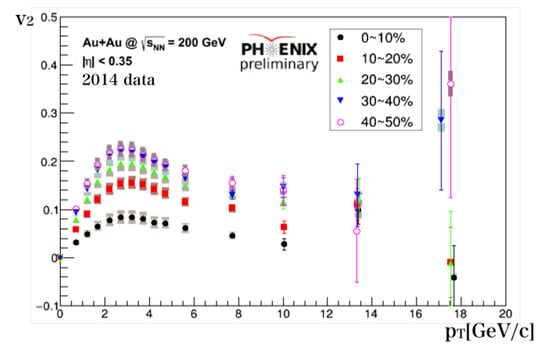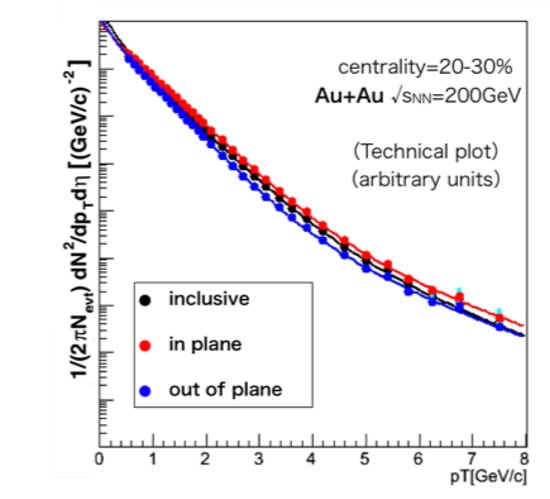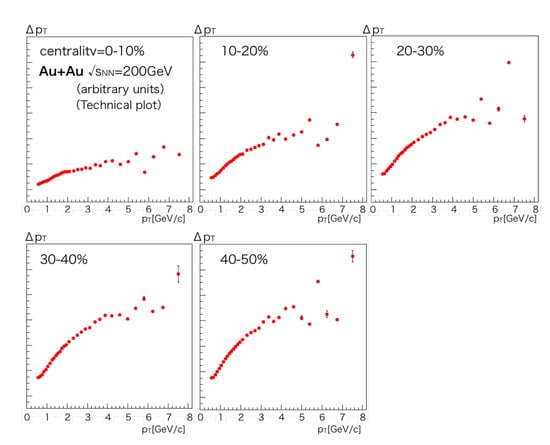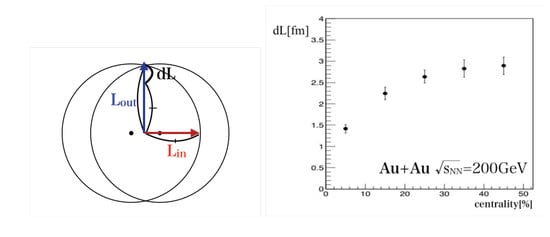Abstract
We study the path length dependence of energy-loss in the Quark Gluon Plasma (QGP) by measuring the azimuthal anisotropy coefficient and transverse momentum () spectra for charged hadrons in Au + Au at = 200 at the RHIC-PHENIX experiment. To estimate the strength of the energy-loss as a function of , we use the which is the difference of which provide the same yields at in-plane and out-of-plane directions. The results indicate that there are different structures between low- and high- regions. At high-, the size of increases as the centrality goes up. We also calculate the difference of the path length of in-plane and out-of-plane directions for each centrality. The difference of the path length increases along with the centrality and the tendency is the same with the results.
1. Introduction
In high energy heavy ion collisions, hard scattered partons can loose their energy because of the interaction with QGP. From the previous results of the nuclear modification factor , it is suggested that the energy-loss plays an important role for the suppression of the yields in QGP relative to nucleon scattering. The previous study in PHENIX by using Au + Au collisions and proton + proton (p + p) collsions [1] has been focused on understanding the strength of energy loss. It compares the strength of the energy loss as a function of transverse momentum () in Au + Au collision from the central collision to the peripheral to that in p + p. The study indicates that the amount of the energy loss at all centralities tends to be independent of the . In this research, we intend to clarify the path-length dependence of the QGP energy-loss. The hard scattered partons have different QGP path-lengths depending on the azimuthal angle of the particle emission. The yield difference at the different azimuthal angle for high- particles in the momentum space can be seen as a result of the different amount of energy-loss in the QGP since the original emission angle should be isotropic, azimuthally. In this analysis, we use the azimuthal anisotropy coefficient () to estimate the azimuthal-angle dependence of the particle yield. The analysis using is unique and has advantages that cancel the systematic errors comparing to the previous method [1], since this method uses only the Au + Au collision system. The strength of energy loss can be investigated by measuring the at high , and we can calculate it more accurately.
2. Analysis Methods
We assume that the azimuthal distribution follows the Equation (1) since we consider only component in this analysis.
We use two previous results, inclusive spectra and the azimuthal anisotropy for charged hadrons, to obtain the “in-plane yield” and the “out-of-plane yield”. The “in-plane” means the plane parallel to the reaction plane direction while the “out-of-plane” is the one perpendicular to that. For this study, we use preliminary results of the azimuthal anisotropy measured by the PHENIX experiment in Au + Au collisions at = 200 in 2014 data shown in Figure 1 [2,3].

Figure 1.
Azimuthal anisotropy coefficient as a function of in Au + Au at = 200 ( PHENIX preliminary results [3], for different region of the centrality from 0–10% to 40–50%. The results are shown by different symbols as explained in the legend.). Bars indicate the statistical errors and boxes indicate the systematic errors.
The inclusive spectrum in Au + Au collisions at = 200 shown as black points in Figure 2, is taken from [4]. For the given range, one can get the azimuthal distribution, Equation (1), illustrated by the black line in the left panel of Figure 3. Here, we define the in-plane yield (out-of-plane yield) as the yield where the azimuthal distribution is assumed to be flat and has a constant value of 1 + 2 (1 − 2) which is the value at . The integral value of the black line is equal to the that of the yellow flat line indicated by “inclusive”. The right panel in Figure 3 shows a cartoon of the inclusive, in-plane and out-of-plane yields as a function of . These three lines can be obtained from the corresponding distributions for a given in the left panel.

Figure 2.
Inclusive, in-plane and out-of-plane yields as a function of for the centrality 20–30% in the Au + Au collisions at = 200 . Bars indicate the statistical errors.

Figure 3.
Left: A typical inclusive azimuthal anisotropic distribution. Right: Cartoon of the inclusive, in-plane and out-of-plane yields as a function of .
Figure 2 shows the differential yield as a function of the in the case of centrality 20 to 30% in Au + Au collisions at = 200 . The black points are the inclusive yield, while the red and the blue points show the particle yields in the in-plane and the out-of-plane, respectively. We fit these yields by a function, f(), given in Equation (2), where , , , , are parameters to be determined by a fit.
We determine the values of these parameters, separately, by fitting the inclusive in-plane and out-of-plane yield. By using the fitting results, one can obtain the values of s, and , that give the same in-plane and out-of-plane yields, respectively ()). We define the difference = - as the estimator of the energy-loss within QGP for given .
3. Results
The obtained values of are shown in Figure 4 as a function of for the various centrality regions from 0 to 50% in 10% steps. In each figure, the vertical axis is and the horizontal is the in-plane . For low the increases as increases. On the other hand, at high , is almost constant, i.e., does not depend on its own . The results indicate that the mechanisms causing the seem to be different between low and high . This is consistent with the previous pictures that the yield difference between in and out of plane at low is due to the elliptic flow [5] and that at high is due to the parton energy loss described in the introduction. The results also indicate that although the shapes are similar for each centrality, for 0–30% centrality, it tends to increase as centrality goes up, and for 30–50% centrality it increases more gently.

Figure 4.
vs. of in-plane in Au + Au collisions at = 200 for the centrality region from 0% to 50% by a 10% step. In this proceeding, we are using an arbitrary scale for the vertical axis. Error bars indicate statistical errors.
In order to study the relation between the and the parton path length within the QGP, we calculate the distance from the center of the collision to the collision surface in-plane direction () and the out-of-plane direction () as the simplest case. We calculate and geometrically from the relationship between the centrality and the impact parameter of gold nuclei, and take the difference between them as shown in the left panel of Figure 5. The radius of the gold nuclei is taken to be . The right panel of Figure 5 shows the calculated dL as a function of the centrality from 0 to 50%. One can clearly see that dL increases with the centrality up to 30%. This behavior is in line with the result for at higher , supporting the interpretation based on a path length dependent energy loss.

Figure 5.
Left: Definition of , and dL. Right: The value of the path-length difference dL as a function of the centrality in Au + Au collisions at = 200 . Error bars indicate the statistical errors.
4. Conclusions
We obtain the in-plane and out-of-plane yields from the inclusive spectra and the measurement using our previous results. From these yields, we estimate the transverse momentum loss, , as a function of (in-plane) for the centrality 0 to 50%. The seems to be independent of its at high . The dL increases along with the centrality and the tendency is the same as for the results.
References
- Adare, A.; Afanasiev, S.; Aidala, C.; Ajitanand, N.N.; Akiba, Y.; Al-Bataineh, H.; Alexander, J.; Aoki, K.; Aramaki, Y.; Atomssa, E.T.; et al. Neutral pion production with respect to centrality and reaction plane in Au+Au collisions at sNN = 200 GeV. Phys. Rev. C 2013, 87, 034911. [Google Scholar] [CrossRef]
- Shimomura, M.; PHENIX Collaboration. PHENIX results on charged-hadron azimuthal anisotropies in Au + Au collisions at center-of-mass energies from 39 to 200 GeV. Nucl. Phys. A 2017, 967, 405–408. [Google Scholar] [CrossRef]
- Takeda, A.; PHENIX Collaboration. Master Thesis at Nara Women’s University p57. 2017. (In Japanese). Available online: http://webhepl.cc.nara-wu.ac.jp/thesis/master.html (accessed on 28 April 2019).
- Addler, S.S.; Afanasiev, S.; Aidala, C.; Ajitanand, N.N.; Akiba, Y.; Alexander, J.; Amirikas, R.; Aphecetche, L.; Aronson, S.H.; Averbeck, R.; et al. High-pT charged hadron suppression in Au + Au collisions at sNN = 200 GeV. Phys. Rev. C 2004, 69, 034910. [Google Scholar] [CrossRef]
- Renk, T.; Ruppert, J. Flow dependence of high pT parton energy loss in heavy-ion collisions. Phys. Rev. C 2005, 72, 044901. [Google Scholar] [CrossRef]
- Adcoxz, K.; PHENIX Collaboration. Formation of dense partonic matter in relativistic nucleus-nucleus collisions at RHIC: Experimental evaluation by the PHENIX collaboration. Nucl. Phys. A 2005, 757, 184–283. [Google Scholar] [CrossRef]
© 2019 by the authors. Licensee MDPI, Basel, Switzerland. This article is an open access article distributed under the terms and conditions of the Creative Commons Attribution (CC BY) license (https://creativecommons.org/licenses/by/4.0/).